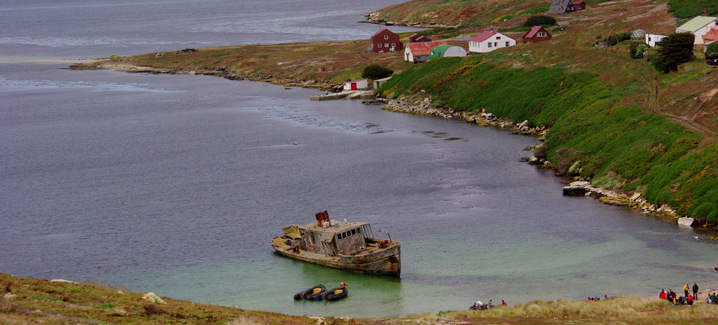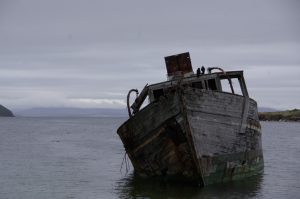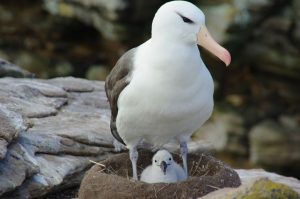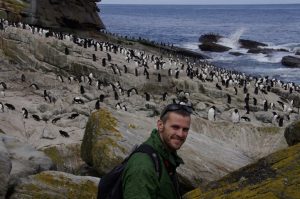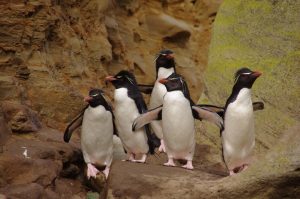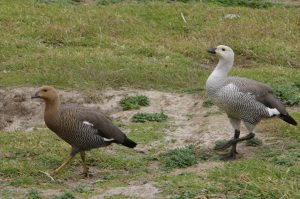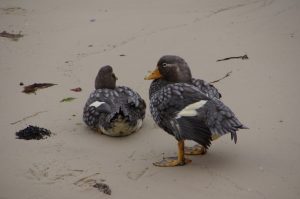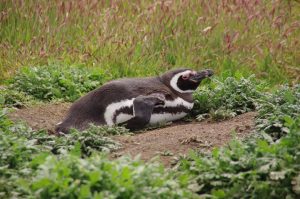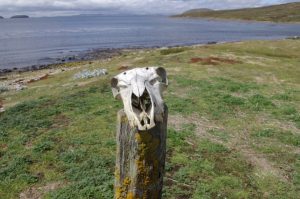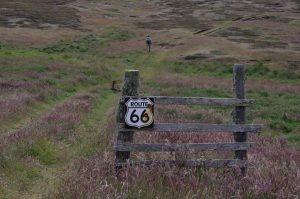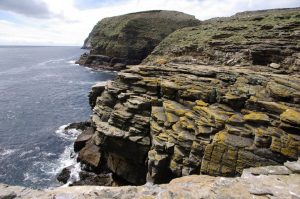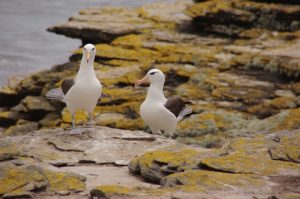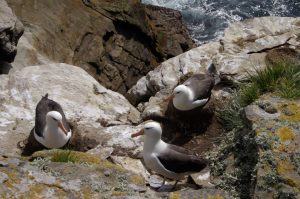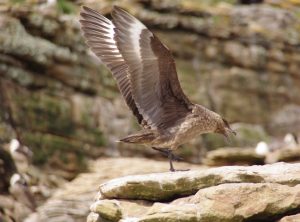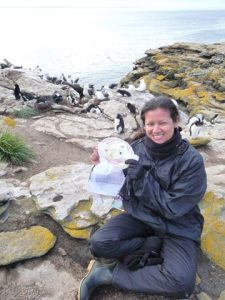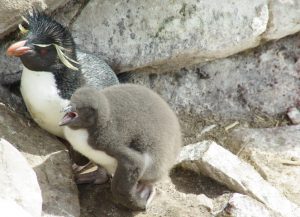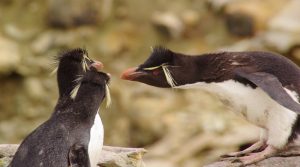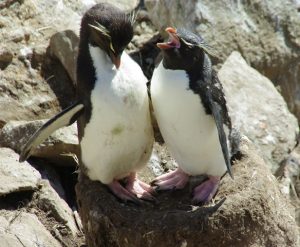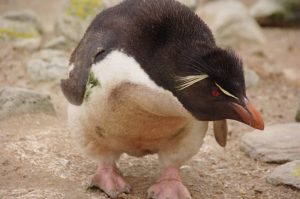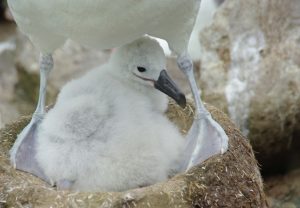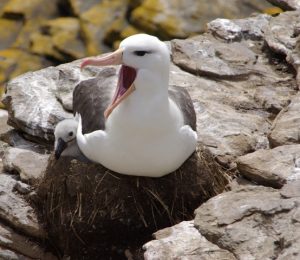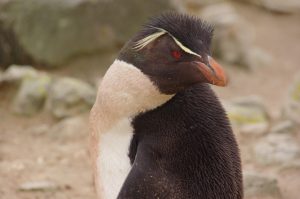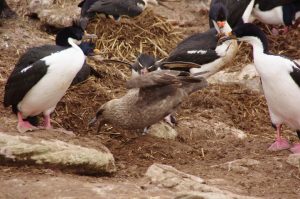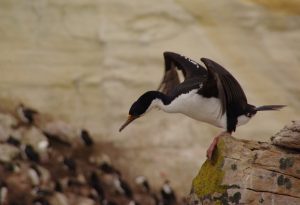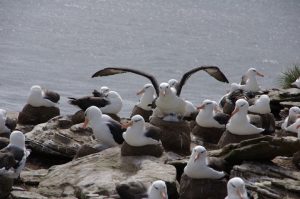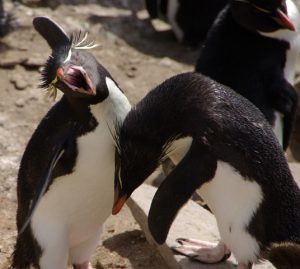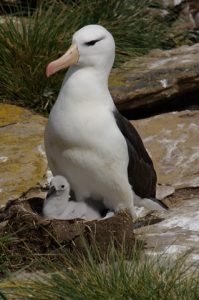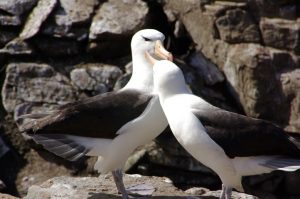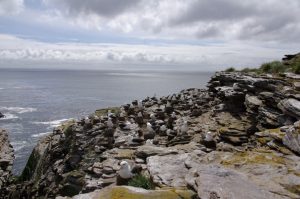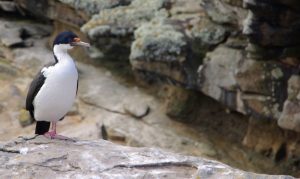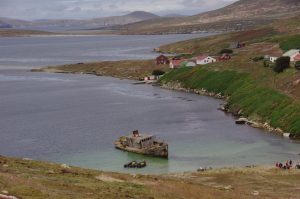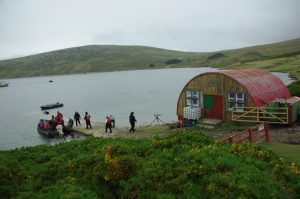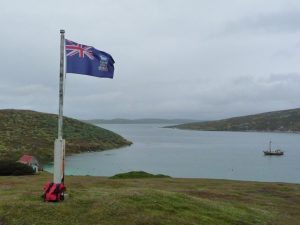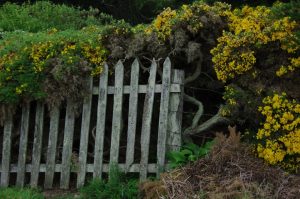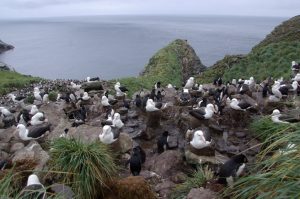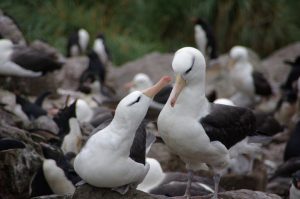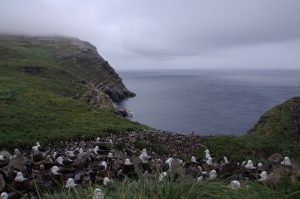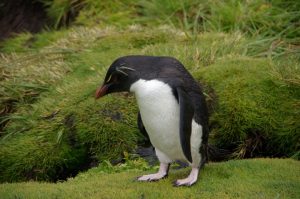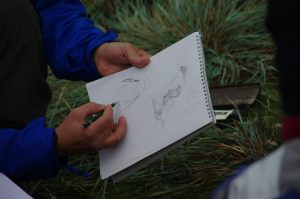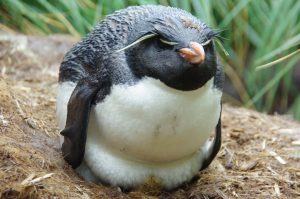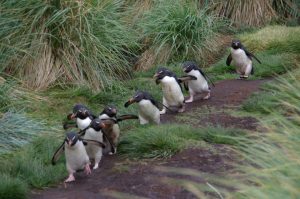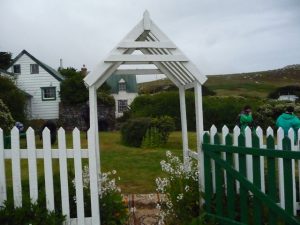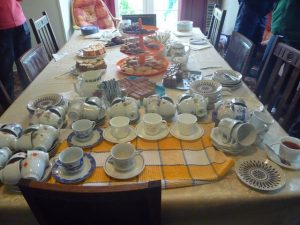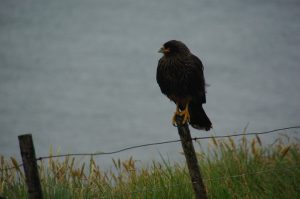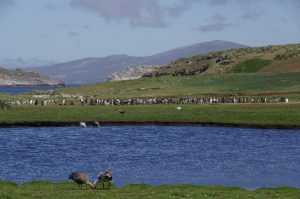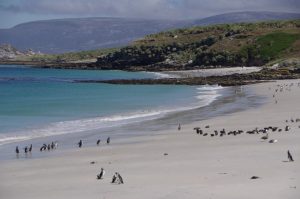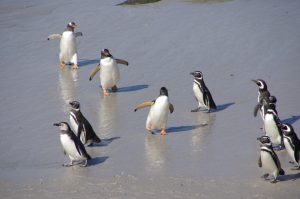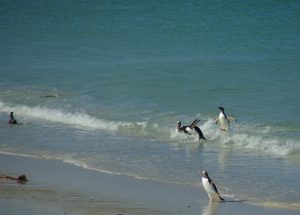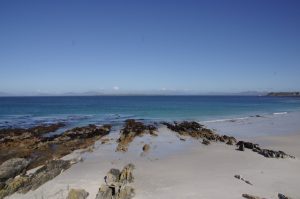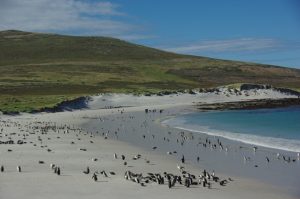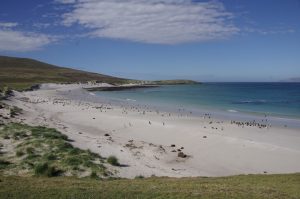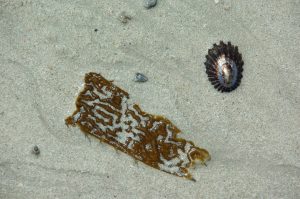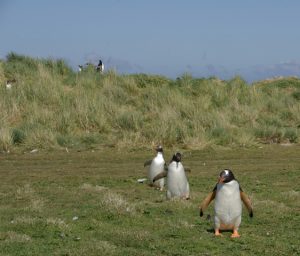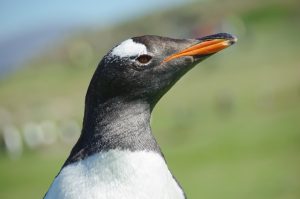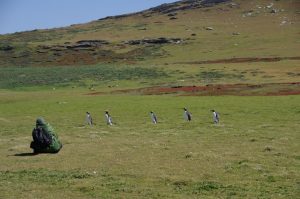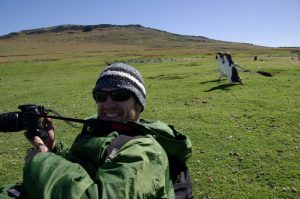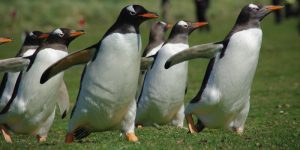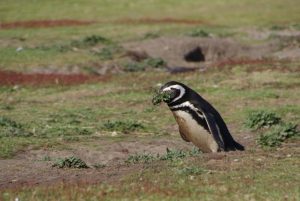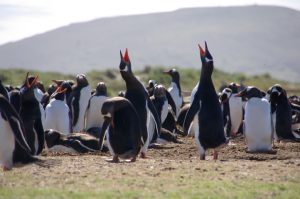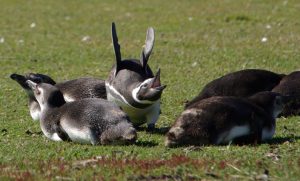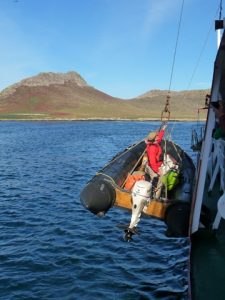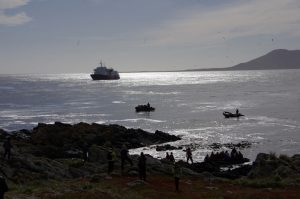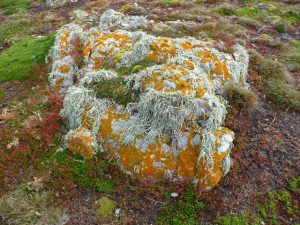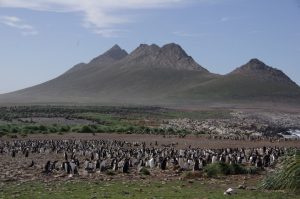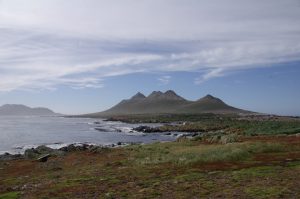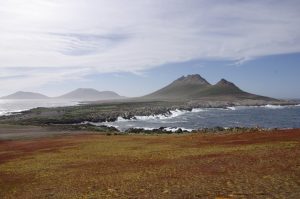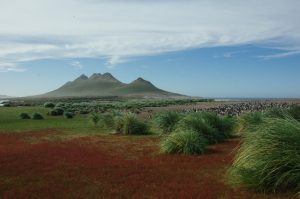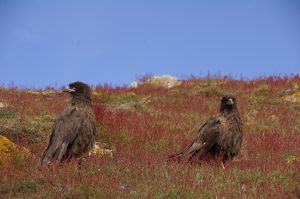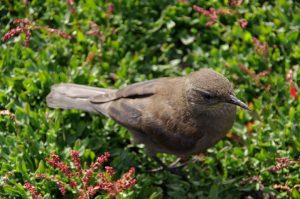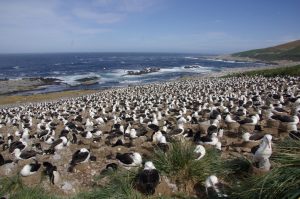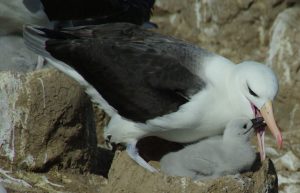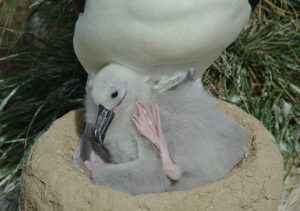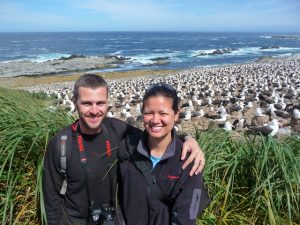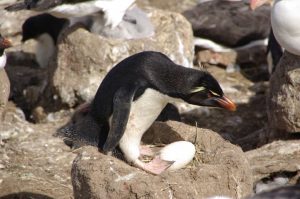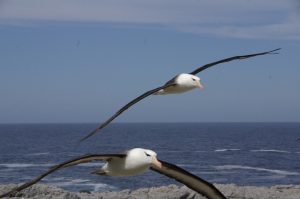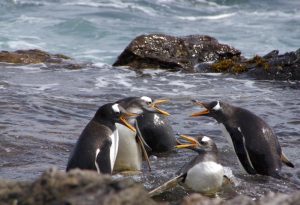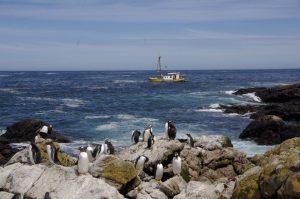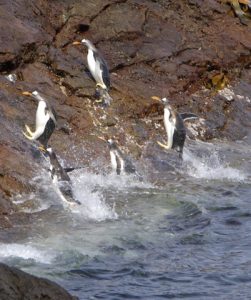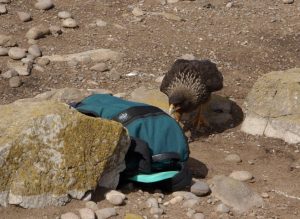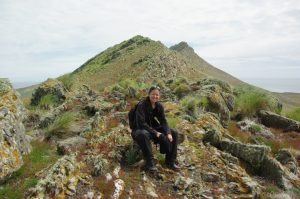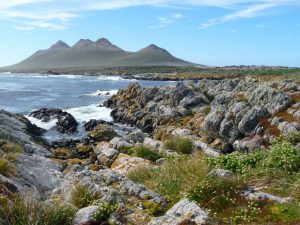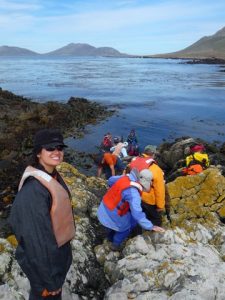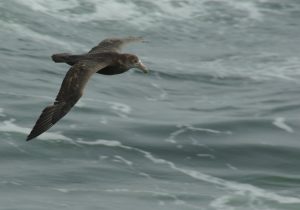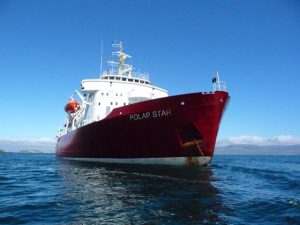The Falkland Islands are an archipelago located 300 miles off the South American coast and 700 miles from Antarctica. We visited New Island, West Point Island, Carcass Island, and last but not least, Steeple Jason (one of 4 islands that comprise the Jason Islands). We found the islands to be some of the most beautiful in the world, with a diverse range of wildlife to include Rockhopper, Gentoo and Magellanic Penguins, Skuas, South American Sea Lions, Black browed Albatrosses, Blue Eyed (Imperial) Shags, and Magellanic Geese. It has been said that some sights are with you for life…that is the case for us with the vista of Steeple Jason’s Black browed Albatross Colony, numbering at over 220,000 pairs. The mere mention of one of our most cherished spots on earth is enough to give us goosebumps…truly bliss on earth.
31 DEC: Thursday: At sea enroute to the Falklands
Our first full sea day! We quickly learned that there would be a routine on board the Polar Star, a “fragrance free” ship. First, we awoke courtesy of Doug Cheeseman’s jubilant “Good morning shipmates” announcement, followed by a scramble to use the shared bathroom before getting ready for breakfast. A breakfast queue would form well before the “Good morning ladies and gentlemen, breakfast is now being served. Bon appétit” announcement, and we would shuffle to join the long line of hungry passengers. There were essentially two lines for breakfast, one for the cold bar (cereal, yogurt, fruit and juice), and one for the hot bar (eggs, oatmeal, pancakes). Lots of our fellow passengers had risen early this morning to capture images of the birds hot on our trail.
We had a full day of lectures planned, starting with Doug’s “national history of the Falkland Islands”, Tom Murphy’s “Photographic composition workshop”, Patrick’s “Introduction to Lightroom and photographic workflow”, Jim’s “Seabird identification”, and Ed Rook’s drawing class. In addition, we had a mandatory lifeboat rehearsal, where we had to don our vests and meet at our respective rally points. We attended all the lectures, and were amazed at how much information we retained, especially with the identification of the birds (sooty shearwaters, black browed albatross, southern giant petrels, pintado petrels, and several others). What was cool was immediately after the lectures, we could stand out on deck and spot the very birds we had learned about.
We aren’t sure why we missed it, but Rod Planck gave a presentation on “photo tips for the Falklands”, and we heard it was excellent. Some of our fellow passengers who were relying on the ship’s stock of wellie boots had a boot fitting session, and we were glad that we had our own to ensure a comfortable fit. After dinner, we laughed our way through Craig’s hysterical “zodiac follies” presentation, and quickly realized that Dr Ross was one funny guy. At 2100 (by zulu time standards it was midnight), the Polar Star staff handed our champagne and we celebrated the new year, singing “Auld Lang Syne” and toasting our fellow shipmates. Pat Brown had a super cute sparkly “2010” headband on, and she looked great. What a great way to ring in the new year.
1 JAN: Friday: New Island, Falklands
We had a 0630 wakeup call for our first landings of the trip. You can imagine everyone’s excitement as we ate breakfast and prepared for the 0800 first zodiac to shore. The weather was brilliant, so we left our heavy jackets in our rooms and opted for our thin fleece jackets instead. Getting ready consisted of going to the bathroom (no facilities on shore!), getting dressed in layers, putting on our water resistant pants followed by our muck boots, and grabbing our camera gear. By the time we grabbed our life vests and waddled out towards the zodiac queue, the line had grown exponentially. Hmm, there must be a way to streamline this process, as we could easily see that the old timers had getting ready down to a science.
Today there were two landing sites at New Island (New Island Settlement and Ship Harbour Bay). According to our daily schedule, both sites required an easy one mile walk to reach the bird colonies. We also had the option of hiking in between the two landing sites, on an easy 7 km or 4.5 mile path up some gentle hills and along a vehicle track. New Island Settlement is located in Coffin’s Bay, a protected cove that is home to Ian Strange and Tony and Kim Chater. Ted Cheeseman had advised everyone last night that this would be one of very few shopping opportunities available to us, as Ian had recently published a beautiful new book, and Tony and Ian were both resident artists with bird prints and artwork for sale. The walk to the rockhopper penguin colony was easy, and once we hit the colony, it was sensory overload. There were penguins as far as the eye could see, and they were loud, boisterous and fascinating to watch. It was thrilling being able to get within 15 feet of the colony for some up close portraits of rockhopper chicks feeding from their parents, or rockhopper penguins doing what they do best (hopping from rock to rock in a comical fashion). Rockhopper penguins are crested (black and white penguins with yellow crests and red bills and eyes) penguins, and we had only ever seen them in cartoons (Surf’s Up and Happy Feet). It was amazing…we had a few hours here and it seemed that the time flew by. Before we knew it, three hours had passed, and we only had 45 minutes to make our way down a nearby gulley to see the rockhoppers making their way to and from the sea. Since we had been forewarned that it was a slippery path, we gingerly made our way down the slope and were immediately rewarded with a group of 7 rockhoppers blissfully hopping their way down to feed in the ocean. Very cool! Once by the sea, we saw a curious South American sea lion checking us out amidst the crashing waves. At that point, we knew we were hooked…this trip was going to be amazing if we were going to continually get as close to the wildlife as we were, and watch them uninterrupted on our own for hours.
Our packed lunches (prepared by chef Bryan Hanson) were ready at the landing at 11 am, and we stumbled over to grab ours close to noon, since our plan was to hike over to the second landing anyway. The sandwiches were delicious, and we had cookies and an apple as well, making for the perfect snack before our 4.5 mile hike. Our hike was leisurely, and to our surprise, unguided. It was awesome to walk at our own pace and on our own timeline, passing by Magellanic penguin burrows. The magellanic penguins were easy to identify as they have black backs, white stomachs, and two black bands between their head and breast, with the lower bank in the shape of an inverted horseshoe shape. Their burrows are particularly fragile, so we made sure to stay on the marked path. It would be awful to accidentally collapse their burrow with our heavy footsteps and murder a penguin chick! The weather continued to be spectacular, and we were thoroughly enjoying our time on New Island.
The second landing (Ship Harbour) was equally as amazing as the first. We got to see hundreds of nesting black browed albatross, up close and personal. They are the most widespread and common albatross, and are easily identifiable with their nasal passages that attached to their upper bill (called a naricorn). The naricorn is used to facilitate desalinating their bodies, as they spend long flights foraging above the ocean water, and it is used to excrete the saline solution away from their nose. We saw several albatross going through their mating displays, and it is an intricate dance between two loving birds. We absolutely fell in love with the albatross on this day, making it one of our favorite birds on earth. Just amazing birds! There were also some rockhopper penguins here, in addition to some Blue Eyed Imperial Shags. We were mesmerized with the amazing vistas before us, and before we knew it, the last zodiac to the ship (1900) was upon us. What an excellent way to start our tour. We both kept pinching ourselves and wondering if we were in a dream…did such places on earth actually exist? It was truly a magical day.
2 JAN: Saturday: West Point and Carcass, Falklands
We had a 0600 wake up call, and the first zodiac was at 0730. Our destination this morning was West Point island, a rare dry landing. We pulled up alongside a dock, and opted to hike the 1.5 miles to the penguin rookery. For those who weren’t keen on climbing the brief steep slope towards the settlement, followed by a solid mile and a half through the hills to the eastern side of the island, the Cheesemans had coordinated two landrovers to transport them and their gear. The walk was brisk and invigorating, and it didn’t take us long to reach the rockhopper colony at Devil’s nose on West Point. In fact, we beat most of the folks waiting for a ride, as only 6 passengers at a time could be transported via the landrover. Once we got to the colony, a staff member gave us our briefing and showed us exactly where we could and couldn’t go within the colony. We were able to get surprisingly close to the rockhoppers, and they were trumpeting, cackling, and chattering up a storm. Rockhoppers are funny penguins to watch up close, their yellow crests/eyebrows shaking almost constantly. In addition to the rockhopper rookery, there were some black browed albatross nests for those of us who couldn’t get enough of the beloved albatross. We made our way down to a nearby stream, where we were able to watch the rockhoppers hop from their smelly and dirty colony down to the stream to rinse off and clean/groom their feathers. They were hilarious to watch, and we could have spent hours here. Alas, we still had to make our way back to the landing, and the last zodiac back to the ship was at 1100. Since we had all been invited to have some tea and cookies at the very friendly West Point resident’s house, we decided to hop on a landrover to buy us some extra time. The cookie and cake spread was delicious, and very generous for the residents of beautiful West Point to share with us.
At 1100, we were back on the Polar Star and started relocating to Carcass Island, a process that took about three hours. The first zodiac to leopard beach on Carcass Island was at 2 pm. Leopard Beach is a wide sandy beach where Magellanic Penguins come ashore past patrolling Southern Sea lions. Carcass island is unique in that it has no rats, and native species can thrive here. The McGill Family owns Carcass Island, and they have worked very hard to protect and restore it. Ted Cheeseman asked for any interested volunteers who wanted to assist in a beach clean up to meet down by the beach, where any trash that had collected on the beach could be policed up.
We hiked from Leopard Beach to Dyke Bay, which housed a beautiful white sandy beach that Gentoo penguins were constantly making their way to and from. It was really cool to see the gentoos pummeling their bodies out of the surf, and watching a column of gentoos navigating their way down the steep beach slope to the ocean. Some of our fellow passengers had massive lenses and were able to capture the action of the penguins popping out of the surf…amazing! Back behind the beach on the grassy terrain, Hugh Rose showed Pat Brown how to crouch real low, and move real slowly towards the Gentoo colony, and we watched in envy. Once Hugh saw us, he told us to mimic Pat and make our way really slowly and methodically to the colony. It was awesome to be able to get so close to the colony unobtrusively. The penguins didn’t mind us at all, in fact some of them would approach us in curiosity but most just ignored us as they went about their business. We really enjoyed watching the colony, and it was the first time we witnessed the penguin mating call, also known as “ecstatic vocalization”. Near the gentoo colony were a couple of Magellanic penguin burrows, and we watched as the magellanics worked feverishly to build their burrows, transporting grass and twig bundles in their beaks. Afterwards, we made our way towards the beach again and just sat and admired the view all around us…penguins on the beach preening, grooming and fluffing up their feathers, a couple of tired penguins slowly trudging up the sand bank in “penguin highways” towards their colony, and a couple of oyster catchers wading on the beach scavenging for food. Another amazing day. We were on one of the last zodiacs to the ship (around 1830) and were again super satisfied at our day and the trip thus far. We both agreed that, at least from our initial impressions, this journey was going to far exceed our expectations.
3 JAN: Sunday: Steeple Jason, West Falklands
Steeple Jason is one of four islands within the Jason Island chain (South Jason, Grand Jason, Flat Jason and Steeple Jason). We read beforehand that with its twin pinnacles, Steeple is the most dramatic of the four. Steeple is surrounded by low lying land around the shore, which rises quickly into a steep peak, hence the island’s name. It is also notable as one of the world’s major breeding grounds for black browed albatross, one of our favorite birds! Over 70% of the world’s population breeds in the Falklands, and we were excited to learn that an estimated half a million albatross nest on Steeple Jason, along three miles of coastline. Interspersed between the albatross are breeding rockhopper penguin pairs. We had also been warned about the Falkland’s unusual bird of prey, the “Johnny Rook”, or striated Caracara, which is a member of the Falcon family.
Our daily schedule informed us that Steeple Jason “runs six miles from northwest to southeast, and a mile across at the widest. At one time sheep, seals and penguins were farmed here, but happily Steeple Jason has been preserved for wildlife since 1970. The new owners, the NY Bronx Zoological Society, opened a field station 4 years ago at the northeast end beyond the rookeries, so we may meet the field researchers running the station.” We had an early (0530) wake up call, followed by breakfast. The first zodiac landing was planned to occur at 0700, but as the Polar Star neared Steeple Jason, it was obvious that the ocean swells were too dangerous, so we had to wait for the ship to reposition at a more sheltered location. This cost us about an hour of our overall shore time (we had an early afternoon departure deadline from the Falklands to South Georgia). Our zodiac driver navigated us past large beds of kelp that surrounded the island, and it was a bit tricky scrambling up to the landing site’s jagged rocks. We were told to navigate the treacherous terrain slowly and in a controlled manner. Everyone heeded this sound advice, as it would have been terrible to cut our trip short due to an avoidable injury this early in the trip.
The Cheeseman staff had marked a walkable route from the landing zone to the albatross colony with red and black flags, and we were warned to steer clear of the sometimes aggressive, dive-bombing Johnny Rooks. We kept the large gentoo colony to our left, and noticed a caracara scavenging on the carcass of a recently killed gentoo. It was amazing to get up close to the inquisitive and unafraid caracaras, and we were able to take quite a few nice shots of them. What we had come to love about this trip so far was the complete amount of autonomy that the staff gave us. There was no hand holding, or babysitting. Basically, we were on our own from the landing site to the colony, enjoying the well marked, easy trail across sloping terrain. Once we got to the albatross colony, we were met by the euphoric pair of Patrick Endres and Jim Danzenbaker, who gave us a quick briefing on one of the world’s most amazing sights. The albatross colony was massive, extending as far out as the eye could see. We had to scramble down tall tussock grass to get to the edge of colony, and it literally took our breath away. What an amazing sight! We were mesmerized watching the albatross in their daily activities of preening, courting, nesting and feeding their super cute chicks. It was just awesome and awe inspiring. It amused us to see rockhopper penguins that had infiltrated the albatross colony, with one of them hopping up into an albatross nest, pretending to nurse an imaginary egg! It was so funny. Even though the staff had forewarned us to expect the scavenging skuas and Johnny Rooks to patrol the colony in search of an easy meal, it didn’t make it any more bearable to see them dive bomb the colony to prey on an unguarded chick or egg.
Even though Ted had proclaimed this was one of his favorite places on earth, we had no idea what he meant until we experienced it for ourselves first hand. After taking photos to our heart’s content, we decided to check out the flight patterns of the albatross returning and taking off to sea. They are such graceful birds in the air, riding on thermal currents without flapping their wings, making their flight seem effortless. Take that extreme of flight perfection, and compare it to their rather clumsy and out of control landing, and it made for hours of endless entertainment. We both marveled at our amazing luck with the fantastic weather, as we had perfect blue skies. It was in fact quite warm, and we were glad that we didn’t wear too many layers this morning, at one point even stripping down to our base layer and soaking in the sun. Sandwiches were available at the landing site from 11 am onward, so at around noon, we headed back to enjoy a quick meal. Oystercatchers showed little fear as they darted mere feet from us in search of food. The brownies were amazing, and after enjoying our meal, we headed towards the Gentoo colony for a catnap between the tussock grass clumps. After awaking feeling rejuvenated, we headed down to the rocky shoreline where we could see the gentoo penguins (joined by a few intrepid rockhoppers) bath in a shallow pool and hop fearlessly into the surging surf. We clambered down to both sides of a gulley to capture the action from various angles, and reluctantly headed back to the landing site at 1630 for the last zodiac ride back to the Polar Star. It was another amazing day, and we really enjoyed all that the Falklands had to offer.
Our afternoon agenda included some light snacks in the observation lounge, as the Polar Star bid adieu to the Falklands and headed towards South Georgia. Since our gear had to be inspected prior to being allowed to disembark in South Georgia, we decided to get a head start on everyone else by snagging a vacuum from the fourth floor bar area immediately before dinner. After dinner, we attended Craig Poore’s “War in the Falklands/Malvinas” lecture, which was an educational synopsis of why the war between the British and Argentinians broke out in the first place.
